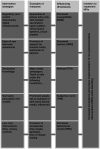Pointers to Interventions for Promoting COVID-19 Protective Measures in Tourism: A Modelling Approach Using Domain-Specific Risk-Taking Scale, Theory of Planned Behaviour, and Health Belief Model
- PMID: 35846656
- PMCID: PMC9277178
- DOI: 10.3389/fpsyg.2022.940090
Pointers to Interventions for Promoting COVID-19 Protective Measures in Tourism: A Modelling Approach Using Domain-Specific Risk-Taking Scale, Theory of Planned Behaviour, and Health Belief Model
Abstract
Based on the factors of the Theory of Planned Behaviour (TPB), the Health Belief Model (HBM), and the DOSPERT scale, used to measure general risk-taking behaviour, a combined model has been developed for investigating tourists' intentions to implement protective measures against the coronavirus disease 2019 (COVID-19). The purpose of the study is to formulate a model that Swiss tourism practitioners can use to understand tourists' decision-making regarding the acceptance and proper implementation of non-pharmaceutical interventions (NPIs). A large-scale cross-sectional population study that is representative for the Swiss population has been designed to validate the model (N = 1,683; 39% response rate). In our empirical investigation, a simple regression analysis is used to detect significant factors and their strength. Our empirical findings show that the significant effects can be ordered regarding descending effect size from severity (HBM), attitude (TPB), perceived behavioural control (TPB), subjective norm (TPB), self-efficacy (HBM), and perceived barriers (HBM) to susceptibility (HBM). Based on this information, intervention strategies and corresponding protective measures were linked to the social-psychological factors based on an expert workshop. Low-cost interventions for tourists (less time, less money, and more comfort), such as the free provision of accessories (free mask and sanitizers) or free testing (at cable cars), can increase the perceived behavioural control and lower the perceived barriers and thus increase the acceptance of this protective measure.
Keywords: COVID-19; Health Belief Model (HBM); Theory of Planned Behaviour (TPB); intervention design; risk taking measurement; tourism.
Copyright © 2022 Ohnmacht, Hüsser and Thao.
Conflict of interest statement
The authors declare that the research was conducted in the absence of any commercial or financial relationships that could be construed as a potential conflict of interest.
Figures




Similar articles
-
A comparative study of eight COVID-19 protective measures and their impact on Swiss tourists' travel intentions.Tour Manag. 2023 Aug;97:104734. doi: 10.1016/j.tourman.2023.104734. Epub 2023 Jan 25. Tour Manag. 2023. PMID: 36712143 Free PMC article.
-
A combined theory-based explanatory model for predicting tourists' travel intentions during the COVID-19 pandemic: the role of individual's assessment of the compliance with non-pharmaceutical interventions.Discov Psychol. 2022;2(1):36. doi: 10.1007/s44202-022-00046-2. Epub 2022 Sep 20. Discov Psychol. 2022. PMID: 40477725 Free PMC article.
-
Predicting intentions to get the COVID-19 vaccine in India: An integration of theory of planned behaviour and health belief model.Int J Health Plann Manage. 2023 Jan;38(1):214-238. doi: 10.1002/hpm.3582. Epub 2022 Sep 27. Int J Health Plann Manage. 2023. PMID: 36164891 Free PMC article.
-
The Validity of the Theory of Planned Behaviour for Understanding People's Beliefs and Intentions toward Reusing Medicines.Pharmacy (Basel). 2021 Mar 9;9(1):58. doi: 10.3390/pharmacy9010058. Pharmacy (Basel). 2021. PMID: 33803406 Free PMC article. Review.
-
The health belief model and theory of planned behavior applied to mammography screening: A systematic review and meta-analysis.Public Health Nurs. 2021 May;38(3):482-492. doi: 10.1111/phn.12842. Epub 2020 Nov 30. Public Health Nurs. 2021. PMID: 33258163
Cited by
-
A comparative study of eight COVID-19 protective measures and their impact on Swiss tourists' travel intentions.Tour Manag. 2023 Aug;97:104734. doi: 10.1016/j.tourman.2023.104734. Epub 2023 Jan 25. Tour Manag. 2023. PMID: 36712143 Free PMC article.
-
What Factors Will Influence Chinese International Traveling for Leisure in the Post-COVID-19 Era: Role of Health Priorities and Health-Related Information Literacy.Healthcare (Basel). 2023 Jan 20;11(3):315. doi: 10.3390/healthcare11030315. Healthcare (Basel). 2023. PMID: 36766891 Free PMC article.
-
A combined theory-based explanatory model for predicting tourists' travel intentions during the COVID-19 pandemic: the role of individual's assessment of the compliance with non-pharmaceutical interventions.Discov Psychol. 2022;2(1):36. doi: 10.1007/s44202-022-00046-2. Epub 2022 Sep 20. Discov Psychol. 2022. PMID: 40477725 Free PMC article.
-
The Effect of Base Theory Educational Intervention on Health-Promoting Lifestyle in Women Susceptible to Cardiovascular Diseases: Application of the Theory of Planned Behavior.Cardiol Res Pract. 2023 Jul 21;2023:8528123. doi: 10.1155/2023/8528123. eCollection 2023. Cardiol Res Pract. 2023. PMID: 37519305 Free PMC article.
References
-
- Abraham V., Bremser K., Carreno M., Crowley-Cyr L., Moreno M. (2020). Exploring the consequences of COVID-19 on tourist behaviors: perceived travel risk, animosity and intentions to travel. Tour. Rev. 76, 701–717. doi: 10.1108/TR-07-2020-0344 - DOI
-
- Agyeiwaah E., Adam I., Dayour F., Badu Baiden F. (2021). Perceived impacts of COVID-19 on risk perceptions, emotions, and travel intentions: evidence from Macau higher educational institutions. Tour. Recreat. Res. 46, 195–211. doi: 10.1080/02508281.2021.1872263 - DOI
-
- Aiken L. S. (2011). “Advancing health behavior theory: the interplay among theories of health behavior, empirical modeling of health beahviour, and behavioural interventions,” in The Oxford Handbook of Health Psychology. ed. Friedman H. S. (Oxford: Oxford University Press; ), 612–636.
-
- Ajzen I. (1985). “From intentions to actions: a theory of planned behaviour,” in Action Control: SSP Springer Series in Social Psychology. eds. Kuhl J., Beckmann J. (Berlin: Springer; ), 11–39.
LinkOut - more resources
Full Text Sources

